 Kia Soul: Manual heating and air conditioning
Kia Soul: Manual heating and air conditioning
The heating and cooling system can be controlled manually by pushing buttons other than the AUTO button.
In this case, the system works sequentially according to the order of buttons selected.
When pressing any button (or turning any knob) except AUTO button while automatic operation, the functions not selected will be controlled automatically.
1. Start the engine.
2. Set the mode to the desired position.
3. Set the temperature control to the desired position.
4. Set the air intake control to the outside (fresh) air position.
5. Set the fan speed control to the desired speed.
6. If air conditioning is desired, turn the air conditioning system on.
Press the AUTO button in order to convert to full automatic control of the system.
Mode selection
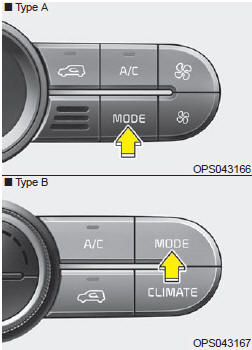
The mode selection button controls the direction of the air flow through the ventilation system.
Refer to the illustration in the “Manual climate control system”.
The air flow outlet port is converted as follows:

Vent mode (B, D)

Air flow is directed toward the upper body and face. Additionally, each outlet can be controlled to direct the air discharged from the outlet.
Vent-Floor mode (B, D, C, E)

Air flow is discharged towards the face and floor.
Floor mode (C, E, A, D)

Most of the air flow is directed to the floor, with a small amount of the air being directed to the windshield and side window defroster.
Floor/Defrost mode (A, C, E, D)

Most of the air flow is directed to the floor and the windshield with a small amount directed to the side window defrosters.
Defrost mode (A, D)
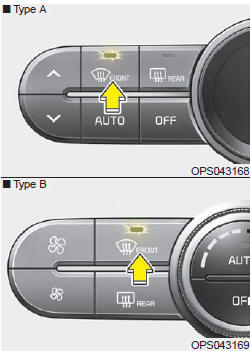
Most of the air flow is directed to the windshield with a small amount of air directed to the side window defrosters.
Instrument panel vents
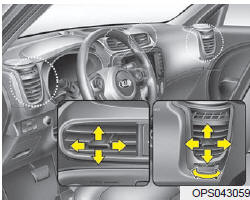
The outlet port can be opened or closed separately using the thumbwheel.
Also, you can adjust the direction of air delivered from these vents using the vent control lever as shown.
Temperature control
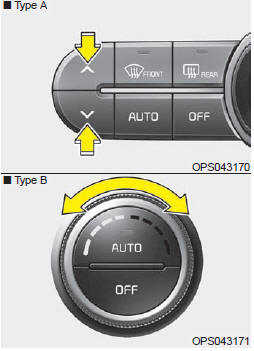
Type A
The temperature will increase to the maximum (HI) by pushing the button (
 ).
).
The temperature will decrease to the minimum (Lo) by pushing the button (
 ).
).
When pushing the button, the temperature will increase or decrease by 0.5°C/1°F. When set to the lowest temperature setting, the air conditioning will operate continuously.
Type B
The temperature will increase to the maximum (HI) by turning the knob to the right extremely.
The temperature will decrease to the minimum (Lo) by turning the knob to the left extremely.
When turning the knob, the temperature will increase or decrease by 0.5°C/1°F. When set to the lowest temperature setting, the air conditioning will operate continuously.
Temperature scale conversion
If the battery has been discharged or disconnected, the temperature mode display will reset to Centigrade.
This is normal condition. You can switch the temperature scale as follows; While pressing the AUTO button, press the OFF button for 3 seconds or more. The temperature scale will change from Centigrade to Fahrenheit, or from Fahrenheit to Centigrade.
The temperature unit (from °C to °F or from °F to °C) can be changed by using the “User Settings” mode of the LCD display.
Air intake control
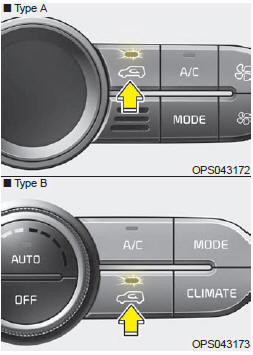
This is used to select outside (fresh) air position or recirculated air position.
To change the air intake control position, push the control button.
Recirculated air position

The indicator light on the button illuminates when the recirculated air position is selected.
With the recirculated air position selected, air from passenger compartment will be drawn through the heating system and heated or cooled according to the function selected.
Outside (fresh) air position

The indicator light on the button does not illuminate when the outside (fresh) air position is selected.
With the outside (fresh) air position selected, air enters the vehicle from outside and is heated or cooled according to the function selected.
WARNING - Recirculated air
Continuous use of the climate control system in the recirculated air position can cause drowsiness or sleepiness, and loss of vehicle control. Set the air intake control to the outside (fresh) air position as much as possible while driving.
WARNING - Reduced visibility
Continued climate control system operation in the recirculated air position may allow humidity to increase inside vehicle which may fog the glass and obscure visibility.
It should be noted that prolonged operation of the heating in recirculated air position will cause fogging of the windshield and side windows and the air within the passenger compartment will become stale.
In addition, prolonged use of the air conditioning with the recirculated air position selected, will result in excessively dry air in the passenger compartment.
Fan speed control
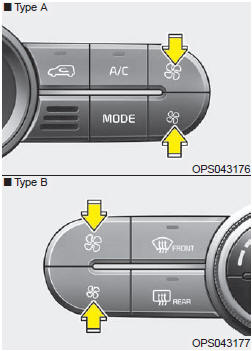
The fan speed can be set to the desired speed by pressing the fan speed control button.
To change the fan speed, press the button (
 )
for higher speed, or push the button (
)
for higher speed, or push the button ( ) for lower speed. To turn the fan speed control off, press the OFF button and select
outside (fresh) air position.
) for lower speed. To turn the fan speed control off, press the OFF button and select
outside (fresh) air position.
Air conditioning
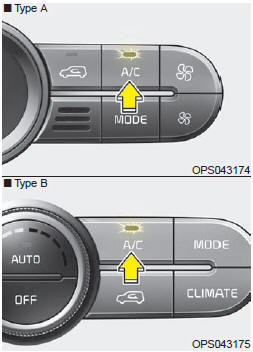
Push the A/C button to turn the air conditioning system on (indicator light will illuminate).
Push the button again to turn the air conditioning system off.
Blower OFF
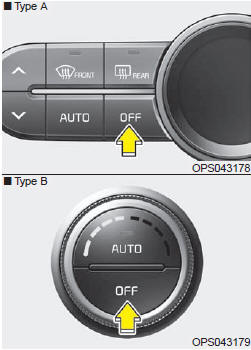
Push the OFF button to turn off the blower. However you can still operate the mode and air intake buttons as long as the ignition switch is in the position ON.
Climate information screen selection (if equipped)
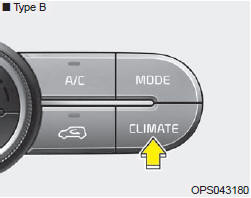
Press the climate information screen selection button to view climate information in full screen mode.
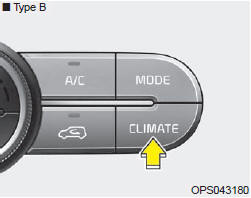
 Automatic heating and air conditioning
Automatic heating and air conditioning
1. Push the AUTO button. It is indicated by AUTO on the display. The modes, fan
speeds, air intake and air-conditioning will be controlled automatically by temperature
setting.
2. Push th ...
 System operation
System operation
Ventilation
1. Set the mode to the
position.
2. Set the air intake control to the outside (fresh) air position.
3. Set the temperature control to the desired position.
4. Set the fan speed con ...
See also:
Center console storage
These compartments can be used to store small items required by the driver or
front passenger.
To open the center console storage, pull up the lever. (Type B) ...
Parking Brake
Inspect the parking brake system including the parking brake lever (or
pedal) and cables.
Adjustment
Parking Brake Lever Stroke Adjustment
1.
Remove the rear console ...
Pre-tensioner seat belt
Your vehicle is equipped with driver's and front passenger's pre-tensioner seat
belts. The purpose of the pretensioner is to make sure that the seat belts fit tightly
against the occupan ...
